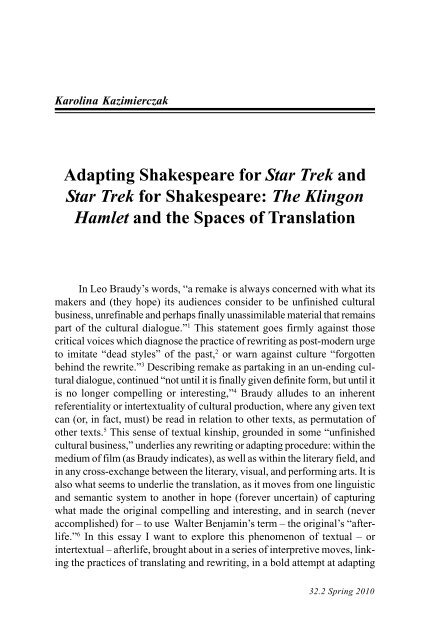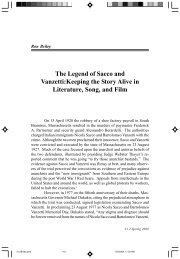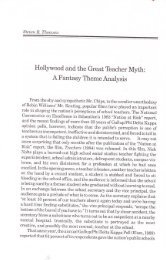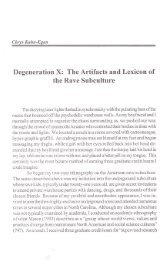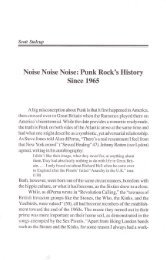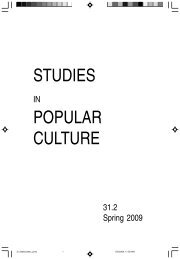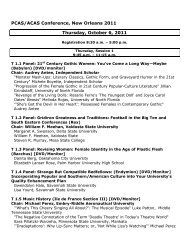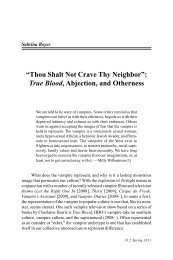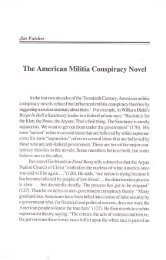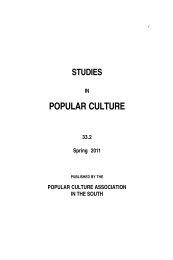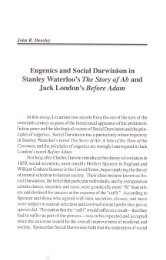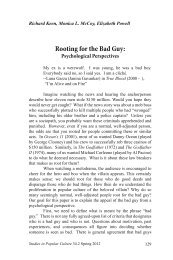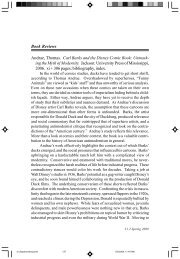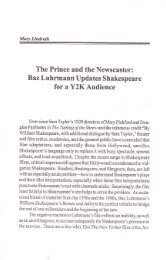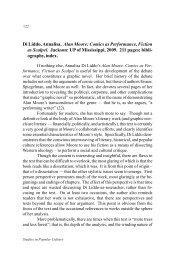Adapting Shakespeare for Star Trek and Star Trek for Shakespeare ...
Adapting Shakespeare for Star Trek and Star Trek for Shakespeare ...
Adapting Shakespeare for Star Trek and Star Trek for Shakespeare ...
Create successful ePaper yourself
Turn your PDF publications into a flip-book with our unique Google optimized e-Paper software.
Karolina Kazimierczak<br />
The Klingon Hamlet <strong>and</strong> the Spaces of Translation 35<br />
<strong>Adapting</strong> <strong>Shakespeare</strong> <strong>for</strong> <strong>Star</strong> <strong>Trek</strong> <strong>and</strong><br />
<strong>Star</strong> <strong>Trek</strong> <strong>for</strong> <strong>Shakespeare</strong>: The Klingon<br />
Hamlet <strong>and</strong> the Spaces of Translation<br />
In Leo Braudy’s words, “a remake is always concerned with what its<br />
makers <strong>and</strong> (they hope) its audiences consider to be unfinished cultural<br />
business, unrefinable <strong>and</strong> perhaps finally unassimilable material that remains<br />
part of the cultural dialogue.” 1 This statement goes firmly against those<br />
critical voices which diagnose the practice of rewriting as post-modern urge<br />
to imitate “dead styles” of the past, 2 or warn against culture “<strong>for</strong>gotten<br />
behind the rewrite.” 3 Describing remake as partaking in an un-ending cultural<br />
dialogue, continued “not until it is finally given definite <strong>for</strong>m, but until it<br />
is no longer compelling or interesting,” 4 Braudy alludes to an inherent<br />
referentiality or intertextuality of cultural production, where any given text<br />
can (or, in fact, must) be read in relation to other texts, as permutation of<br />
other texts. 5 This sense of textual kinship, grounded in some “unfinished<br />
cultural business,” underlies any rewriting or adapting procedure: within the<br />
medium of film (as Braudy indicates), as well as within the literary field, <strong>and</strong><br />
in any cross-exchange between the literary, visual, <strong>and</strong> per<strong>for</strong>ming arts. It is<br />
also what seems to underlie the translation, as it moves from one linguistic<br />
<strong>and</strong> semantic system to another in hope (<strong>for</strong>ever uncertain) of capturing<br />
what made the original compelling <strong>and</strong> interesting, <strong>and</strong> in search (never<br />
accomplished) <strong>for</strong> – to use Walter Benjamin’s term – the original’s “afterlife.”<br />
6 In this essay I want to explore this phenomenon of textual – or<br />
intertextual – afterlife, brought about in a series of interpretive moves, linking<br />
the practices of translating <strong>and</strong> rewriting, in a bold attempt at adapting<br />
32.2 Spring 2010
36 Karolina Kazimierczak<br />
<strong>Shakespeare</strong> <strong>for</strong> <strong>Star</strong> <strong>Trek</strong> <strong>and</strong> <strong>Star</strong> <strong>Trek</strong> <strong>for</strong> <strong>Shakespeare</strong>. I will refer here<br />
to a curious case of the translation of two of <strong>Shakespeare</strong>’s plays – Hamlet<br />
<strong>and</strong> Much Ado About Nothing – into the Klingon language, a language of<br />
a fictitious alien species originating in the <strong>Star</strong> <strong>Trek</strong> television series <strong>and</strong><br />
films.<br />
These projects, aiming at translating two of the canonical texts of<br />
modern English literature into a language linked to one of the biggest popular<br />
culture franchises, emerge at the very center of critical theory’s questioning<br />
of translation <strong>and</strong> its political <strong>and</strong> ethical engagements. Since<br />
Benjamin’s definition of “the task of translator,” 7 the translation has lost its<br />
position of an innocent copy, a truthful representation of some original text.<br />
It is no longer viewed as recreation of the original, but rather as its displacement,<br />
which leads from, but always moves away from, the meaning of the<br />
original. The translation lives by the difference of meanings, 8 <strong>and</strong> of languages,<br />
<strong>and</strong> in uncovering this essential <strong>for</strong>eignness, it opens the space <strong>for</strong><br />
the interaction of the self <strong>and</strong> the other. This interaction remains fragile <strong>and</strong><br />
uncertain, as the translation inevitably seeks to substitute the original meaning<br />
with its own linguistic <strong>and</strong> cultural categories, thus leading to the erasure<br />
of the <strong>for</strong>eignness <strong>and</strong> the ultimate alienation of the other. At the same time,<br />
by confronting the familiarity of translator’s own meaning with the alienness<br />
of the original, it also leads to alienation of that which is familiar in<br />
one’s own language, <strong>and</strong> to the alienation of the self. 9 The Klingon translations<br />
of <strong>Shakespeare</strong>’s works – through sometimes playful stylistic devices,<br />
presenting the translated texts as reconstructions rather than different language<br />
versions of the original, <strong>and</strong> locating them in a broader textual tradition<br />
or narrative reality – become interesting illustrations of those challenges<br />
<strong>and</strong> ambiguities inherent to the translation process: the spaces of<br />
translation. At the same time, by staging <strong>Shakespeare</strong>’s early modern plays<br />
in the futuristic costume of alien civilization, they reveal – <strong>and</strong> creatively<br />
rework – certain representations of language, culture <strong>and</strong> their interrelations<br />
linked to the <strong>Star</strong> <strong>Trek</strong> films <strong>and</strong> series. All along, they raise questions<br />
about the notion of familiarity <strong>and</strong> alien-ness <strong>and</strong> the processes of cultural<br />
re-appropriation as enacted in <strong>and</strong> through language, thus contributing to<br />
the debates on cultural <strong>and</strong> language politics, emerging at the intersections<br />
between translation theory <strong>and</strong> postcolonial studies. They also illustrate cre-<br />
Studies in Popular Culture
The Klingon Hamlet <strong>and</strong> the Spaces of Translation 37<br />
ative links between the official <strong>and</strong> popular culture <strong>and</strong> the role of popular<br />
texts in both enacting <strong>and</strong> reworking established cultural imaginaries.<br />
In the following parts of this essay I will explore some of those points,<br />
while engaging in a close reading of the Klingon translations of Hamlet <strong>and</strong><br />
Much Ado About Nothing, in the context of both <strong>Shakespeare</strong>an tradition<br />
<strong>and</strong> the broader <strong>Star</strong> <strong>Trek</strong> narrative. I will start by looking at the links between<br />
<strong>Shakespeare</strong>’s oeuvre <strong>and</strong> various incarnations of <strong>Star</strong> <strong>Trek</strong> narrative<br />
as both context <strong>and</strong> inspiration <strong>for</strong> the Klingon translations. Following<br />
the trope of a daring “cultural re-appropriation” of <strong>Shakespeare</strong>’s work in<br />
<strong>Star</strong> <strong>Trek</strong> VI: The Undiscovered Country, I will examine the richly layered<br />
intertextual play involved in presenting the Klingon versions of Hamlet<br />
<strong>and</strong> Much Ado About Nothing as reconstructions or restorations, <strong>and</strong> I<br />
will question the consequences of such a bold reinterpretation <strong>for</strong> the underst<strong>and</strong>ing<br />
of translation as “an authentic copy.” Finally, addressing briefly<br />
the issue of the apparent interplay of high <strong>and</strong> popular culture enacted in the<br />
Klingon translations, I will look more closely at the links between language<br />
<strong>and</strong> its cultural context: the colonial context of <strong>Shakespeare</strong>’s plays <strong>and</strong> the<br />
science-fiction / f<strong>and</strong>om context of the Klingon translations recreating, to a<br />
certain extent, some of the colonial representations. In this final part of the<br />
essay I will illustrate the complexities of alienation enacted in these projects,<br />
<strong>and</strong> indicate their consequences <strong>for</strong> the underst<strong>and</strong>ing of the processes of<br />
cultural <strong>and</strong> linguistic re- appropriation. Throughout these discussions I will<br />
attempt to elucidate the double role of popular culture in both subverting <strong>and</strong><br />
re-enacting some prominent cultural representations <strong>and</strong> practices.<br />
– – –<br />
Translating <strong>Shakespeare</strong> <strong>for</strong> <strong>Star</strong> <strong>Trek</strong> <strong>and</strong> <strong>Star</strong> <strong>Trek</strong> <strong>for</strong> <strong>Shakespeare</strong>,<br />
the Klingon versions of Hamlet <strong>and</strong> Much Ado About Nothing exercise a<br />
curious double bind of adaptation. They bring evidence of the afterlife of<br />
the <strong>Star</strong> <strong>Trek</strong> mythology, while at the same time illuminating the links of this<br />
mythology with the afterlife, or “unfinished cultural business,” of<br />
<strong>Shakespeare</strong>’s work. It has been remarked by some critics that <strong>Shakespeare</strong>’s<br />
oeuvre seems particularly susceptible to the “use” <strong>and</strong> “abuse” of countless<br />
adaptations, remakes <strong>and</strong> reinterpretations. 10 This tendency appears linked<br />
to <strong>Shakespeare</strong>’s curious <strong>and</strong> particular position in the cultural space of the<br />
(not exclusively) English-speaking world. This particularity resounds already<br />
in a moniker popularly attributed to signify both his person (however uncer-<br />
32.2 Spring 2010
38 Karolina Kazimierczak<br />
tain his identity might be) <strong>and</strong> his cultural legacy: the Bard. To speak of “the<br />
Bard” is necessarily to speak of William <strong>Shakespeare</strong>. <strong>Shakespeare</strong>’s position,<br />
it seems, is characterized by certain dialectics. On one h<strong>and</strong>, he is<br />
perceived as a canonical source of cultural heritage; on the other h<strong>and</strong>, he<br />
appears as a sort of cultural icon <strong>and</strong> even a part of the ideational furniture<br />
of everyday life. His presence in popular imagination emerges as a network<br />
of, often disjointed or distorted, allusions <strong>and</strong> references. As such <strong>Shakespeare</strong><br />
becomes a textual “fair play” <strong>for</strong> continued rewritings, borrowings <strong>and</strong> trans<strong>for</strong>mations<br />
from language to language, from medium to medium. The <strong>Star</strong><br />
<strong>Trek</strong> franchise in its over 40-year-long history has often contributed to this<br />
phenomenon, freely borrowing ideas, quotations <strong>and</strong> imaginaries linked to<br />
<strong>Shakespeare</strong>’s authorship. 11 It has been argued that this ransacking of the<br />
<strong>Shakespeare</strong>an oeuvre <strong>for</strong> plot devices <strong>and</strong> easily recognizable quotations<br />
was meant to serve as a tool <strong>for</strong> cultural legitimation of <strong>Star</strong> <strong>Trek</strong> as a<br />
popular (there<strong>for</strong>e less “respectable”) text, providing it with “a veneer of<br />
cultural sophistication.” 12 This argument seems to oversimplify the question<br />
of intertextual connections of this science fiction franchise with other texts,<br />
picturing it in terms of the stark opposition between the popular <strong>and</strong> legitimate<br />
culture. As such it fails to account <strong>for</strong> the complexity of multilayered<br />
textual play enacted in some of the <strong>Star</strong> <strong>Trek</strong> episodes <strong>and</strong> films, <strong>and</strong> especially<br />
in <strong>Star</strong> <strong>Trek</strong> VI: The Undiscovered Country.<br />
Nowhere in the whole franchise is <strong>Shakespeare</strong>an influence, this “unfinished<br />
cultural business,” more visible that in the sixth of the <strong>Star</strong> <strong>Trek</strong><br />
films. It starts with the casting of Christopher Plummer <strong>and</strong> David Warner,<br />
two renowned <strong>Shakespeare</strong>an-trained actors, in the roles of the leaders of<br />
the Klingons, a warlike alien species <strong>and</strong> the original villains of the franchise.<br />
Interestingly, this casting strategy seems to have gone against the<br />
earlier practices of the production team, which tended to associate<br />
<strong>Shakespeare</strong>an references with the characters <strong>and</strong> deeds of the Federation<br />
officers. As the comments of the writer <strong>and</strong> director, Nicholas Meyer, suggest,<br />
the <strong>Shakespeare</strong>an background of the actors led to the decision of<br />
incorporating a significant number of “Bardic” references into the screenplay,<br />
particularly in the part of infamous General Chang. 13 However, “the<br />
<strong>Shakespeare</strong>an connection” of <strong>Star</strong> <strong>Trek</strong> VI cannot be judged as entirely<br />
accidental <strong>and</strong> dictated solely by the casting of the leading characters. It is<br />
inscribed much more deeply into the narrative structure of the film <strong>and</strong><br />
Studies in Popular Culture
The Klingon Hamlet <strong>and</strong> the Spaces of Translation 39<br />
starts with its very title, subtitled The Undiscovered Country. This expression<br />
originates in Hamlet’s famous soliloquy starting with the words: “To be<br />
or not to be” (Act III, Scene I). The meaning of this metaphor differs,<br />
however, from its original use: in Hamlet it refers to the unknown of death;<br />
in <strong>Star</strong> <strong>Trek</strong> it represents the unknown of the future. And it is brought <strong>for</strong>th<br />
in this context by the Klingon leader, Chancellor Gorkon, played by David<br />
Warner. Recalling <strong>Shakespeare</strong>’s words, Gorkon alludes to the uncertainty<br />
of the political situation which establishes the dramatic center of the film:<br />
the end of the war between the Klingon Empire <strong>and</strong> the United Federation<br />
of the Planets, the end of the status quo of past decades, <strong>and</strong> the unsure<br />
prospect of an intergalactic peace. What is also alluded to in Gorkon’s comment,<br />
<strong>and</strong> in other <strong>Shakespeare</strong>an references attributed to the Klingons, is<br />
that those galactic villains represent, in fact, “a cultured <strong>and</strong> civilised race,”<br />
“a life-<strong>for</strong>m not dissimilar to ourselves.” 14 There is, however, a curious<br />
twist to this new representation of the Klingons as well-read <strong>and</strong><br />
<strong>Shakespeare</strong>-loving. While quoting liberally from various <strong>Shakespeare</strong>an<br />
sources, the warlike aliens from <strong>Star</strong> <strong>Trek</strong> VI end up claiming the Bard as<br />
their own cultural property.<br />
Chancellor Gorkon’s (in)famous words: “You have not experienced<br />
<strong>Shakespeare</strong>, until you have read him in the original Klingon” have called<br />
<strong>for</strong> many different readings. Kay H. Smith interpreted them from the perspective<br />
of the cultural politics of the cold war era as a sign of displacement<br />
of the conflict between two intergalactic powers. 15 Paul Cantor entertained<br />
the idea that they may signify a disturbing identification of the dying culture<br />
of the warlike Klingons with the virtue of heroism <strong>and</strong> values of heroic<br />
literature. But in the end he decided to reduce their meaning <strong>and</strong> interpret<br />
them as a mark of postmodern referentiality <strong>and</strong> inclination <strong>for</strong> pastiche. 16<br />
The audience of <strong>Star</strong> <strong>Trek</strong>: The Undiscovered Country may have simply<br />
seen the Klingon leader’s comment as a joke: on a narrative level, Gorkon’s<br />
joke about the sense of cultural superiority articulated by the Federation<br />
officers, on an extratextual level, the writers’ mockery of <strong>Shakespeare</strong>’s<br />
iconic status <strong>and</strong> his uncertain identity. But what would have happened if<br />
Gorkon’s words were to be read literally? What would it mean <strong>for</strong><br />
<strong>Shakespeare</strong> to be read as an alien author? What would it be to experience<br />
his work in “the original Klingon”? These questions, so readily dismissed by<br />
some critics as signs of postmodern pastiche, resonated strongly with a<br />
32.2 Spring 2010
40 Karolina Kazimierczak<br />
group of <strong>Star</strong> <strong>Trek</strong> <strong>and</strong> Klingon fans, giving birth to the Klingon <strong>Shakespeare</strong><br />
Restoration Project, a bold attempt at “cultural re-appropriation” of the great<br />
playwright’s oeuvre undertaken by the members of the Klingon Language<br />
Institute. 17<br />
Inspired by the half-serious, half-playful reference to <strong>Shakespeare</strong>’s<br />
authorship from <strong>Star</strong> <strong>Trek</strong>: The Undiscovered Country, <strong>and</strong> by the broader<br />
scholarly aspirations of the KLI, this project aims at translating or – in line<br />
with Gorkon’s words – restoring <strong>Shakespeare</strong>’s entire oeuvre into Klingon,<br />
“an artificial language originally created as nothing more than a prop.” 8 The<br />
involvement of the members of the Klingon Language Institute with<br />
<strong>Shakespeare</strong> <strong>and</strong> Klingon led to the production of two texts: The Klingon<br />
Hamlet, translated by Nick Nicholas <strong>and</strong> Andrew Strader <strong>and</strong> first published<br />
in 1996, <strong>and</strong> Much Ado About Nothing, or to use its Klingon title<br />
paghmo’ tIn mIS (literally: “The Confusion is Great Because of Nothing”),<br />
translated by Nick Nicholas <strong>and</strong> first published in 2001. 19 As with many<br />
other activities of the KLI, the task of “restoring” those two <strong>Shakespeare</strong><br />
plays to their “original” Klingon was influenced by <strong>and</strong> grounded in scholarly<br />
attitudes <strong>and</strong> practices. According to Lawrence M. Schoen, it was a<br />
result of the KLI’s long ef<strong>for</strong>ts to study, teach <strong>and</strong>, consequently, use “the<br />
warrior tongue.” 20 Originating in a linguistically in<strong>for</strong>med knowledge of language,<br />
the translated texts are presented as valid representations of the<br />
original, the outcomes of a legitimate translating procedure, not unlike other<br />
translations of <strong>Shakespeare</strong>. At the same time it should be noted that those<br />
texts are positioned in a project that re-addresses the issue of <strong>Shakespeare</strong>’s<br />
influences within the <strong>Star</strong> <strong>Trek</strong> universe as a textual source <strong>for</strong> the language.<br />
In the case of the Klingon renditions of Hamlet <strong>and</strong> Much Ado<br />
About Nothing, the involvement with <strong>Star</strong> <strong>Trek</strong> textual reality is even stronger<br />
<strong>and</strong> more direct.<br />
Not only does The Undiscovered Country serve as an inspiration <strong>for</strong><br />
those translations, it also provides them with an elaborate “make believe”<br />
narrative context which takes Gorkon’s words at face value <strong>and</strong> presents<br />
the Bard as a Klingon playwright, Wil’yam Shex’pir, who “lived at a time of<br />
crisis <strong>for</strong> the Klingon Empire.” 21 In this bold move of “cultural re-appropriation,”<br />
much more radical than its cinematic source, the translators playfully<br />
redefine the tradition of <strong>Shakespeare</strong>an scholarship, firstly offering alternative<br />
“Klingon” readings of <strong>Shakespeare</strong>’s characters <strong>and</strong> plots. And so a<br />
Studies in Popular Culture
The Klingon Hamlet <strong>and</strong> the Spaces of Translation 41<br />
difficult relationship of Benedick <strong>and</strong> Beatrice, now B’enerdik <strong>and</strong> B’eterirsh,<br />
serves as a model example of Klingon courting behaviour, while Hamlet’s,<br />
or Khamlet’s, story of revenge becomes “a chilling portrayal of malaise<br />
<strong>and</strong> decay” 22 <strong>and</strong> a study of “cultural dispossession”: “while he retains a<br />
sense of Klingon honour, Khamlet is culturally dispossessed, given to<br />
rationalising <strong>and</strong> talk instead of action … His development through the play<br />
is seen as a voyage back to his true Klingon roots, until, at the conclusion of<br />
the play, he dies in honour.” 23<br />
This playful redefinition <strong>and</strong> re-appropriation of <strong>Shakespeare</strong>an tradition<br />
is carefully developed within the translated text, weaving the characters<br />
<strong>and</strong> events of those classic texts with elements of <strong>Star</strong> <strong>Trek</strong>’s extended<br />
universe. The Klingon Hamlet relocates the main events of <strong>Shakespeare</strong>’s<br />
play to Kronos, the Klingon Home World, with Claudius (or tlhaw’DIyuS)<br />
turned into the Klingon Emperor, <strong>and</strong> Fortinbras of Norway (now vortIbraS)<br />
pictured as “the most insubordinate head of the House of Duras.” 24 Other<br />
places <strong>and</strong> characters undergo similar reimagining. The <strong>Star</strong> <strong>Trek</strong> context<br />
of the translated text becomes visible also in the sometimes very imaginative<br />
translations of particular lines or expressions. While the famous “What<br />
a piece of work is a man!” from Act II of Hamlet is literally (<strong>and</strong><br />
unsurprisingly) rendered as “A Klingon is an impressive specimen,” a playful<br />
exchange between the two Clowns in the first scene of Act V is reworked<br />
into a carefully designed word-play, making use of both a reference<br />
to <strong>Star</strong> <strong>Trek</strong>’s recurring humorous plot of “the trouble with tribbles” 25 <strong>and</strong> a<br />
more sophisticated linguistic pun. To quote both the original <strong>and</strong> the literal<br />
translation of this scene:<br />
--What is he that builds stronger than either the mason, the shipwright,<br />
or the carpenter?<br />
--The gallows maker; <strong>for</strong> that frame outlives a thous<strong>and</strong> tenants.<br />
--I like thy wit well, in good faith: the gallows does well; but how<br />
does it well? it does well to those that do ill: now thou dost ill to<br />
say the gallows is built stronger that the church: argal, the gallows<br />
may do well to thee …<br />
--Which of these is the most useful? the engineer, the communications<br />
officer, or the technician?<br />
--A tribble merchant. He is useful to regulate the tribble population<br />
....He buys (je’) hungry tribbles. If you don’t feed (je’) an<br />
entity (Dol), you’ll observe a funeral (nol). You can’t trade (bech)<br />
tribbles <strong>for</strong> food. There<strong>for</strong>e, you’ll suffer (Mech) from a large<br />
32.2 Spring 2010
42 Karolina Kazimierczak<br />
tribble population…<br />
As the Appendix to The Klingon Hamlet explains, the humour of the translated<br />
version is based on the “dialectical puns derived from the st<strong>and</strong>ard<br />
‘Dol’ <strong>and</strong> ‘nol’ (‘entity’ <strong>and</strong> ‘funeral,’ respectively), as well as ‘bech’ <strong>and</strong><br />
‘mech’ (‘trade’ <strong>and</strong> ‘suffer,’ respectively), sounding virtually identical in the<br />
[alleged] dialect.” 26 Examples of similar reinterpretation or re-appropriation<br />
of <strong>Shakespeare</strong>’s words can be found throughout the translated versions of<br />
Hamlet <strong>and</strong> Much Ado About Nothing.<br />
But the re-appropriation of <strong>Shakespeare</strong>’s authorship goes beyond the<br />
text <strong>and</strong> incorporates the whole tradition of the Bard’s scholarship, as the<br />
authors of those “restored Klingon versions” present “so-called Shekispeorian<br />
Criticism” as a “well-organised campaign” of fabrications <strong>and</strong> <strong>Shakespeare</strong>’s<br />
original works as “crude <strong>for</strong>geries.” 27 In this fictive context of “the Klingon<br />
restored version,” The Klingon Hamlet <strong>and</strong> “The Confusion is Great Because<br />
of Nothing” seem to make an important point of the problematic<br />
relationship between the translation <strong>and</strong> its original, as it playfully undermines<br />
the apparent foundations of any translating procedure: the belief that<br />
the translated text is a reliable representation – an “authentic copy” – of the<br />
original. According to postmodern theory, this belief in translation’s fidelity<br />
<strong>and</strong> translator’s transparency is already <strong>and</strong> always illusory, as the translation<br />
inevitably substitutes the categories <strong>and</strong> meanings of the original with<br />
its own linguistic <strong>and</strong> cultural notions. But the embedding of the translated<br />
text in the re-appropriation of <strong>Shakespeare</strong>’s authorship – not only as Klingonlike,<br />
but as Klingon in origin – takes the practice of confronting the meaning<br />
of the original with that of the translated text, enacted in any translation, a<br />
step further. By means of the fictitious introduction, both texts seem to<br />
replace the original with the translation not implicitly, but in a very literal<br />
way. As the subtitle to both publications states, these are not only Klingon<br />
versions of <strong>Shakespeare</strong>’s texts, these are “restored versions,” returning<br />
<strong>Shakespeare</strong>’s texts to the proper <strong>for</strong>m. The Klingon translation becomes a<br />
means of the reinstatement of <strong>Shakespeare</strong>an original.<br />
This notion of translation supplanting the original seems reminiscent of<br />
Emily Apter’s discussions of the sc<strong>and</strong>alous cases of pseudotranslations,<br />
the literary fabrications which claim to be renderings of non-existent, imaginary<br />
sources. 28 In those translations with no source-text, the fantasy of<br />
translation’s fidelity can be finally exposed. What is equally revealed is an<br />
illusory dominance of the original. The pseudotranslation, the “reproduction<br />
Studies in Popular Culture
The Klingon Hamlet <strong>and</strong> the Spaces of Translation 43<br />
of absent original,” shows how the ambiguity of the relationship between a<br />
text <strong>and</strong> its translation is enacted on both sides of this dyad: in the fallibility<br />
of translation <strong>and</strong> in the absence of the original. The Klingon versions of<br />
<strong>Shakespeare</strong>’s works can perhaps be perceived as the examples of such<br />
pseudotranslation, but only in a most curious way. For they are not translations<br />
without the original, but the translations pretending to be the original<br />
texts. They exercise a double mystification: they present themselves as the<br />
originals <strong>and</strong> the originals as translations, which – through a “well-organised<br />
campaign” of fabrications – managed to falsely acquire the status of the<br />
origins. Attributing their own mystifying procedure to the original texts <strong>and</strong><br />
building their fictive legitimation, the Klingon translations seem to disturb<br />
the rightful order between <strong>Shakespeare</strong> as the source-text <strong>and</strong> <strong>Star</strong> <strong>Trek</strong> as<br />
its reworking. In fact, what they disturb – just as pseudotranslation does – is<br />
the reader’s underst<strong>and</strong>ing of the relationship between the original <strong>and</strong> the<br />
version: translation or adaptation. This picturing of <strong>Shakespeare</strong>’s plays as<br />
“crude <strong>for</strong>geries” of the Klingon original texts serves as a playful reminder<br />
that there is no end <strong>and</strong> also no beginning to the intertextual referencing <strong>and</strong><br />
mirroring.<br />
Juxtaposed to this playful redefinition of <strong>Shakespeare</strong>an tradition is<br />
the actual presentation of the texts, which mirrors the <strong>for</strong>mat of the comparative<br />
translations <strong>and</strong> provides the English <strong>and</strong> Klingon texts side by side<br />
in apparently perfect structural correspondence. This structural likeness is<br />
particularly visible in The Klingon Hamlet that, according to its translators,<br />
manages to recreate iambic pentameter of the English original, or should<br />
we say “<strong>for</strong>gery.” To quote just few examples emphasized in Appendix II:<br />
- / - / - / - / - /<br />
bijatlh ‘e’ mev! peqIm! DaH cholqa’ bIH!<br />
Peace, break thee off; look, where it comes again!<br />
/ - - / - / - - - / -<br />
taH pagh taHbe’. DaH mu’tlheghvam vIqeInIS.<br />
To be or not to be; that is the question. 29<br />
In both those instances the Klingon “restored versions” seem to make<br />
a claim implicit in all translations: that a translated text is an accurate or<br />
valid representation of the original. In the words of the members of the<br />
Klingon Language Institute, this claim of fidelity comes dressed in the costume<br />
of <strong>Star</strong> <strong>Trek</strong>’s textual reality:<br />
32.2 Spring 2010
44 Karolina Kazimierczak<br />
If Humans <strong>and</strong> Klingons are to underst<strong>and</strong> this play – <strong>and</strong> by<br />
implication the world in which the players inhabit – then surely<br />
the key is to be found in the language. Accuracy, a highly valued<br />
Klingon trait, is thus of critical importance. 30<br />
By contrasting the fictive context of <strong>Shakespeare</strong>’s Klingon authorship<br />
with a respectful, scholarly, in<strong>for</strong>med attitude to a corpus of his works,<br />
the Klingon <strong>Shakespeare</strong> Restoration Project becomes an interesting illustration<br />
of the politics of translation, <strong>and</strong> particularly its links with the processes<br />
of cultural re-appropriation. It also brings into light the complex <strong>and</strong><br />
often problematic relationship between high culture texts <strong>and</strong> practices <strong>and</strong><br />
their popular re-enactments.<br />
– – –<br />
Stating as its source <strong>Star</strong> <strong>Trek</strong>: The Undiscovered Country, the project<br />
readdresses the issue of <strong>Shakespeare</strong>'s influences within the <strong>Trek</strong> narratives.<br />
Just as <strong>Shakespeare</strong>an <strong>and</strong> other literary references included in the<br />
series <strong>and</strong> feature films did, it poses the question of the relation between<br />
<strong>Shakespeare</strong> as representation of high culture <strong>and</strong> <strong>Star</strong> <strong>Trek</strong> as the embodiment<br />
of popular culture, <strong>and</strong> at the same time questions the validity of such<br />
juxtapositions. If – as several critics claim 31 – the introduction of<br />
<strong>Shakespeare</strong>an allusions is to grant <strong>Star</strong> <strong>Trek</strong> a “veneer of sophistication”<br />
or “cultural legitimation,” does the inclusion of <strong>Star</strong> <strong>Trek</strong> references into a<br />
translation of <strong>Shakespeare</strong>’s plays in turn deprive the translated texts of<br />
their rightful place in the literary canon, of their high culture status? The<br />
Klingon Hamlet, with its images of Hamlet <strong>and</strong> William <strong>Shakespeare</strong>, bearing<br />
the features recognizable as typical <strong>for</strong> the Klingon characters from<br />
later TV series <strong>and</strong> films, <strong>and</strong> with the disclaimers stating that “<strong>Star</strong> <strong>Trek</strong>”<br />
<strong>and</strong> “Klingon” are registered trademarks of Paramount Pictures, seems to<br />
be making <strong>Shakespeare</strong> not only a part of the <strong>Star</strong> <strong>Trek</strong> universe, but also a<br />
part of its franchise. The Klingon Hamlet – like almost all Klingon publications<br />
– is a licensed product of Paramount Pictures, 32 <strong>and</strong> the same could<br />
perhaps be said of Wil’yam Shex’pir, the Bard’s Klingon alter ego. But the<br />
issue of textual referencing between those two texts is much more complex.<br />
<strong>Shakespeare</strong> is not, <strong>and</strong> in fact cannot be made into a part of the <strong>Star</strong><br />
<strong>Trek</strong> universe. He is already a part, by virtue of his partaking in the greater<br />
text of Western culture. <strong>Star</strong> <strong>Trek</strong>, both textually as a fictive projection of<br />
the civilization of the future having its roots in the past <strong>and</strong> present of the<br />
Western world, <strong>and</strong> extratextually as a contemporary popular text, belongs<br />
Studies in Popular Culture
The Klingon Hamlet <strong>and</strong> the Spaces of Translation 45<br />
to the very same tradition. And, in line with Kristeva’s definition of<br />
intertextuality, 33 this greater text of Western culture is, in turn, a part of both<br />
<strong>Shakespeare</strong>’s corpus <strong>and</strong> the <strong>Star</strong> <strong>Trek</strong> narrative. In the end the introduction<br />
to the “restored Klingon versions” of Hamlet <strong>and</strong> Much Ado About<br />
Nothing, offering an elaborate reading of <strong>Shakespeare</strong>’s extraterrestrial<br />
legacy, appears to be nothing other than a parody with its tradition (once<br />
again Western) of unsettling the relation between the official <strong>and</strong> the popular.<br />
As such it seems to work to counter those readings of <strong>Star</strong> <strong>Trek</strong> <strong>and</strong><br />
<strong>Shakespeare</strong> which search to underline the opposition between high <strong>and</strong><br />
low in culture.<br />
Paradoxically, just as in the case of the dialectical reading of the relationship<br />
between the original <strong>and</strong> its translation, it seems to work also to<br />
counter the intentions of the translators who – to a certain degree – seem to<br />
share the notion of the validity of such orderings. As Sarah Ekstrom, the<br />
coordinator of the Klingon <strong>Shakespeare</strong> Restoration Project, explains its<br />
origins: “For some viewers the line [from <strong>Star</strong> <strong>Trek</strong> VI] produced hearty<br />
chuckles <strong>and</strong> knowing nods. Among others it served as inspiration. This<br />
volume is the finished product crafted by just a few from among the inspired.”<br />
34 The translations of Hamlet <strong>and</strong> Much Ado About Nothing are<br />
thus the result of a more serious, “inspired” reaction to interpretational possibilities<br />
opened by The Undiscovered Country. One cannot but notice,<br />
however, that – despite its subversive qualities – the introduction to those<br />
texts seems to contribute rather to those “hearty chuckles” <strong>and</strong> “knowing<br />
nods.” It also undermines the claims of Lawrence M. Schoen, the director<br />
of the KLI, who presents the translations as an evidence of the development<br />
of the language from a television prop into a popular culture icon, <strong>and</strong><br />
– more implicitly – of its elevation to the status of functional language, no<br />
longer just a part of the <strong>Star</strong> <strong>Trek</strong> franchise:<br />
The volume you hold should be ample evidence of Klingon’s<br />
evolution, from the sound stage to popular culture, from a back<br />
lot at Paramount Pictures to Klingon <strong>and</strong> <strong>Star</strong> <strong>Trek</strong> fans throughout<br />
the world. Working with only a thin grammar <strong>and</strong> a glossary<br />
of some two thous<strong>and</strong> words the membership of the KLI has<br />
studied the language, taught the language, engaged in word<br />
play from puns to palindromes, composed original poetry <strong>and</strong><br />
fiction, translated books of the Bible, <strong>and</strong> now perhaps the most<br />
well known of <strong>Shakespeare</strong>’s plays, Hamlet. 35<br />
32.2 Spring 2010
46 Karolina Kazimierczak<br />
And so the inclusion of the <strong>Star</strong> <strong>Trek</strong> narrative frame into the Klingon<br />
translation of <strong>Shakespeare</strong>’s two plays both subverts <strong>and</strong> rein<strong>for</strong>ces the<br />
oppositional orderings between high culture text <strong>and</strong> their popular re-enactments<br />
or reinterpretations. At the same time, it calls <strong>for</strong>th the question of<br />
the links between language <strong>and</strong> its cultural background, be it <strong>Shakespeare</strong>’s<br />
early modern English verse with its colonial connotations, or invented alien<br />
idiom with its roots in science fiction franchise <strong>and</strong> its f<strong>and</strong>om.<br />
– – –<br />
Presenting the translated texts as elements of <strong>Star</strong> <strong>Trek</strong>’s reality seems<br />
to weaken the argument of the emancipation of the Klingon language from<br />
the textual context in which it originated. It appears that, despite the attempts<br />
of its propagators to employ it in many different cultural contexts,<br />
the language cannot escape its association with the phenomenon of <strong>Star</strong><br />
<strong>Trek</strong>. One could ask, however, if such a divorce of the language <strong>and</strong> its<br />
textual source is even possible. Are not all languages always bound by their<br />
contexts, geographically, historically <strong>and</strong> politically located? It should not<br />
come as a surprise, then, that the Klingon language would be perceived as<br />
a language of a fictitious people, one of many populating the world of <strong>Star</strong><br />
<strong>Trek</strong>. It is an inherent element of the <strong>Star</strong> <strong>Trek</strong> mythos, in<strong>for</strong>med by this<br />
mythos, <strong>and</strong> in turn contributing to it. It is natural that this “mythical” or<br />
textual locality should penetrate translation made in this language. In this<br />
respect, the “Klingon restored versions” of <strong>Shakespeare</strong>’s plays, particularly<br />
The Klingon Hamlet, demonstrate a curious parallelism with ethnically<br />
localized adaptations of <strong>Shakespeare</strong>’s works, such as (as discussed<br />
by Catherine Silverstone) the case of The Maori Merchant of Venice. 36<br />
This parallelism is not to be read in any instance as a relation of similarity. If<br />
there is a comparison to be made between those texts, it is not the one<br />
between the representations of the Maori language <strong>and</strong> culture <strong>and</strong> those of<br />
the <strong>Star</strong> <strong>Trek</strong> universe <strong>and</strong> the Klingons. The correspondence of these two<br />
cases resides purely in an enactment of certain textual techniques which<br />
calls <strong>for</strong> a deeper consideration.<br />
The Maori Merchant of Venice is a cinematic adaptation of<br />
<strong>Shakespeare</strong>’s play, which – in the words of its creators – uses “Maori<br />
language <strong>and</strong> cultural elements as a vehicle to be able to express the dynamics<br />
that <strong>Shakespeare</strong> came up with.” 37 Silverstone draws attention to<br />
several aspects of the linguistic <strong>and</strong> cultural dynamics enacted in this translation<br />
/ adaptation, considering the complex relationship between the lan-<br />
Studies in Popular Culture
The Klingon Hamlet <strong>and</strong> the Spaces of Translation 47<br />
guage of <strong>Shakespeare</strong>, which also happens to be the language of cultural<br />
colonization of the Maori people, <strong>and</strong> te reo, the Maori native language. She<br />
emphasizes the introduction of the qualifier “Maori” into the English title of<br />
the film, which differentiates this particular version from other renditions of<br />
the play, <strong>and</strong> at the same time displaces <strong>Shakespeare</strong>’s original title of The<br />
Merchant of Venice <strong>and</strong> his authority:<br />
the use of the word Maori to supplement the English title partially<br />
displaces the primacy of <strong>Shakespeare</strong> from the enterprise:<br />
the promise of the title is that <strong>Shakespeare</strong>’s Merchant will be<br />
remade by Maori <strong>and</strong> in Maori. This process of displacement is<br />
further promised through the renaming of <strong>Shakespeare</strong>’s characters<br />
with Maori names: Hairoka <strong>for</strong> Shylock, Pohia <strong>for</strong> Portia,<br />
Anatonio <strong>for</strong> Antonio, Patanio <strong>for</strong> Bassanio. 38<br />
The importance of the Maori context is also enacted through the casting<br />
of Maori actors <strong>and</strong> introduction of objects <strong>and</strong> locations associated<br />
with the Maori culture. All those elements are, however, juxtaposed with<br />
the images of another cultural setting commonly associated with <strong>Shakespeare</strong><br />
<strong>and</strong> his authorship: that of Elizabethan Engl<strong>and</strong>. As Silverstone concludes,<br />
“The Maori Merchant, with its representation of Maori actors in Renaissance<br />
costumes, counterpoised against more familiar signifiers of Maori<br />
culture, seems to play parody with the notion of cultural authenticity <strong>and</strong><br />
‘exoticism.’” 39 In other words, it accentuates the difference between the<br />
original <strong>and</strong> the adapted text, between the language <strong>and</strong> culture of<br />
<strong>Shakespeare</strong> <strong>and</strong> the language <strong>and</strong> culture of the Maori people, thus revealing<br />
the mechanisms of alienation present in any cultural translation.<br />
Paradoxical though it may seem, the Klingon translation / adaptation<br />
of Hamlet appears to mirror The Maori Merchant of Venice in all those<br />
instances, starting with the displacement of <strong>Shakespeare</strong>’s authority in the<br />
very title of the volume. It is The Klingon Hamlet, not “<strong>Shakespeare</strong>’s<br />
Hamlet rendered in the Klingon language.” In fact, the author’s name is not<br />
to be found anywhere on the cover or on the title page of this publication. It<br />
has been replaced by the two trademarked labels: “Klingon” <strong>and</strong> “<strong>Star</strong> <strong>Trek</strong>.”<br />
The title of the translated text seems thus to encourage a culturally specific<br />
reading of the play as located within the <strong>Star</strong> <strong>Trek</strong> universe <strong>and</strong> attributed to<br />
the fictitious Klingons. This interpretation is further supported by the transliteration<br />
of characters’ names according to the Klingon language spelling<br />
convention, turning Claudius into tlhaw’DiyuS <strong>and</strong> Ophelia into ‘ovelya.<br />
32.2 Spring 2010
48 Karolina Kazimierczak<br />
The most explicit clue <strong>for</strong> the Klingon reading of the text comes, of course,in<br />
the <strong>for</strong>m of the already discussed introduction.<br />
The Klingon Hamlet mirrors the adapting procedures of The Maori<br />
Merchant of Venice also in its curious blending of a culturally located<br />
interpretation with the established <strong>Shakespeare</strong>an tradition. This mixing<br />
of two textual conventions is conveyed in the visual imaginary connected<br />
to the work: in the cover illustration presenting the hero of the<br />
play <strong>and</strong> in a portrait of its author. The cover illustration, created by Phil<br />
Foglio, displays Hamlet st<strong>and</strong>ing on top of the battlements of a castle,<br />
holding a skull in an iconic pose associated with the soliloquy “To be or<br />
not to be.” In case the image does not recall this association, the scene<br />
is captioned with the famous phrase rendered both in English <strong>and</strong> in<br />
Klingon. The cover title pronounces that the text presented in the volume<br />
is a “Klingon Hamlet” <strong>and</strong> the illustration strives to support this<br />
claim through the physical appearance of the hero. Hamlet’s head, <strong>and</strong><br />
the skull which he is holding in his right h<strong>and</strong>, are marked by the <strong>for</strong>ehead<br />
ridges typical <strong>for</strong> the later imaginings of the Klingons. In his left<br />
h<strong>and</strong> he carries a bat’leth, the Klingon's favorite weapon, <strong>and</strong> this element<br />
has clearly been added to redress the otherwise un-Klingon-like melancholic<br />
character of this scene. These images are contrasted with other<br />
visual clues referring in turn to <strong>Shakespeare</strong>an tradition. And so Klingon<br />
Hamlet st<strong>and</strong>s on the battlements of a seemingly medieval castle, <strong>and</strong> he is<br />
clothed in a Renaissance costume. What sets his clothing apart from other<br />
<strong>Shakespeare</strong>an costumes is a subtle incorporation of the Imperial Trefoil, a<br />
symbol of the Klingon Empire, into its decoration. A similar blending of<br />
those two contexts is visible in a portrait of William <strong>Shakespeare</strong>, or rather<br />
Wil’yam Shex’pir, drawn by Gennie Summers. This picture combines the<br />
Klingon facial features with Renaissance costume complete with a moustache<br />
<strong>and</strong> a beard typical <strong>for</strong> more traditional representations of the Bard.<br />
The images of Hamlet, or Khamlet, <strong>and</strong> Wil’yam Shex’pir seem to<br />
recall <strong>Star</strong> <strong>Trek</strong>’s long-st<strong>and</strong>ing tradition of the play-within-the-play episodes,<br />
especially the later introduction of holographic technology <strong>and</strong> a<br />
holodeck space, which allowed the characters to enact intertextual borrowings<br />
in full costume. 40 At the same time, by overemphasising the difference<br />
between the two contexts, they serve as a parody of both <strong>Shakespeare</strong>an<br />
tradition <strong>and</strong> the representations of the fictive Klingon culture. And so, perhaps<br />
unconsciously, the creators of The Klingon Hamlet, <strong>and</strong> also “the<br />
Studies in Popular Culture
The Klingon Hamlet <strong>and</strong> the Spaces of Translation 49<br />
Klingon restored version” of Much Ado About Nothing, appear to be alluding<br />
to the spaces of difference <strong>and</strong> alienation governing the process of<br />
translation.<br />
In Blanchot’s words, translation is “the very life” of the difference<br />
between the languages, <strong>and</strong> the translator, its “secret master.” 41 He or she<br />
reveals the <strong>for</strong>eignness of two languages: the language of the original <strong>and</strong><br />
the language of its translation, the language of the author <strong>and</strong> his or her own<br />
language. In doing so, the translator makes visible “what makes this work<br />
such that it will always be other.” 42 This interplay between the self <strong>and</strong> the<br />
other, between one’s own meaning <strong>and</strong> the other’s, is a paramount feature<br />
of translation, which should never be perceived as an achieved work, but<br />
rather as a trace: a trace of history, a cultural trace, but most of all a trace<br />
of the other. For a translation can only, <strong>and</strong> only perhaps, be realized in “the<br />
possibility of anterior presence, without guarantees” of the other <strong>and</strong> his/<br />
her meaning. 43 This meaning is to be found in “a trace” of the other, which<br />
is never the same as “a sign,” <strong>and</strong> this terminological turn suggests how<br />
fleeting <strong>and</strong> ungraspable that meaning is. Of course, in view of Lévinas’<br />
writings, it must remain such if we are still to speak of the relation of<br />
<strong>for</strong>eignness or otherness. To look into the <strong>for</strong>ms of the other <strong>and</strong> find oneself<br />
is to equate him or her with the self, “[t]o translate the neighbour is to<br />
turn him/her/it into a category of our own language <strong>and</strong> so to deny him/her/<br />
it otherness.” 44 Translation is there<strong>for</strong>e always <strong>and</strong> inevitably also alienation.<br />
“What I translate is upset by the way I translate,” exclaims Lévinas,<br />
indicating how this process affects those who could never be understood. 45<br />
Paul de Man reminds us that “this alienation is at its strongest in our relation<br />
to our own language,” its meaning stripped of its familiarity through the<br />
comparison with the <strong>for</strong>eign. 46 To translate is to alienate both the other <strong>and</strong><br />
the self.<br />
The Klingon versions of <strong>Shakespeare</strong>’s works seem to recall some of<br />
those arguments. In those texts a reader is confronted with several essential<br />
questions. Whose meaning is enacted in those translations? Whose otherness<br />
is emphasized? Whose language is alienated? In brief, who is “the<br />
other” in this particular “cultural translation”? The Klingon translations seem<br />
to offer several possible answers to this important issue, giving evidence of<br />
the complex play of alien-ness <strong>and</strong> othering enacted in these projects. The<br />
first <strong>and</strong> most obvious answer is that the other is in this case to be identified<br />
with an alien in its most literal sense: as an imaginary, warlike, nonhuman<br />
32.2 Spring 2010
50 Karolina Kazimierczak<br />
people, the Klingons. And this interpretation gives perhaps the most accurate<br />
insight into the process of othering enacted in every translation. Translated<br />
into the linguistic categories of the self, presented as either the self’s<br />
likeness or its absolute opposite, is not the other always necessarily imaginary?<br />
That would be the argument of Lévinas, Derrida, Spivak, <strong>and</strong> the<br />
post-colonial studies. 47 But the space of difference in Klingon translation is<br />
open <strong>for</strong> other interpretations. The mark of the <strong>for</strong>eignness may be fixed on<br />
an imaginary culture in an imaginary future, but it is the imaginary envisaged<br />
by Gene Roddenberry, the creator of the <strong>Star</strong> <strong>Trek</strong> franchise. And it is<br />
also this vision of the world, where the feudal, aggressive, expansionist, but<br />
heroic civilization of the Klingon Empire is confronted with <strong>and</strong> overcome<br />
by the rational, liberal, democratic <strong>and</strong> – one may add – sanitized culture of<br />
the Federation, that is alienated in these texts. Another space of difference<br />
called <strong>for</strong>th in The Klingon Hamlet <strong>and</strong> the Klingon version of Much Ado<br />
About Nothing is the difference of language itself, perceived on the<br />
metalinguistic level, not as much as a difference of meaning, but as a <strong>for</strong>eignness<br />
of a linguistic system. The Klingon language was famously constructed<br />
to “appear alien.” It is also this vision of linguistic “alien-ness”<br />
created by Marc Okr<strong>and</strong> that the Klingon translations uncover. The process<br />
of alienation is not necessarily limited to the <strong>Star</strong> <strong>Trek</strong> context of this<br />
translation. It may well be that – compared with the popular context of<br />
science fiction genre <strong>and</strong> fictitious culture of the Klingons – it is <strong>Shakespeare</strong>,<br />
his works <strong>and</strong> their cultural context, that appear “alien” to the eyes of the<br />
reader. Finally, as Paul de Man remarked, every translation brings <strong>for</strong>th the<br />
alienation of the translator’s own language. 48 It can be argued that, in the<br />
end, those who are really alienated in the Klingon versions of <strong>Shakespeare</strong>’s<br />
texts are Klingon users <strong>and</strong> translators themselves, confronted with various<br />
possible identities <strong>and</strong> various <strong>for</strong>ms of otherness (as science fiction fans,<br />
linguistic scholars, <strong>Shakespeare</strong> aficionados, or geeky enthusiasts of obscure<br />
languages). And what is ultimately displaced in this process of “restoration”<br />
is the translators’ own language (both English <strong>and</strong> Klingon!), their<br />
categories (of literary <strong>and</strong> scholarly work, of popular <strong>and</strong> high culture) <strong>and</strong><br />
their imaginaries (of Klingon culture, <strong>Shakespeare</strong>’s tradition, <strong>and</strong> the Klingon<br />
users’ community).<br />
– – –<br />
Studies in Popular Culture
The Klingon Hamlet <strong>and</strong> the Spaces of Translation 51<br />
The “Klingon restored versions” of Hamlet <strong>and</strong> Much Ado About<br />
Nothing mark a particular re-incarnation of <strong>Shakespeare</strong>’s afterlife <strong>and</strong><br />
also, one may add, that of the <strong>Star</strong> <strong>Trek</strong> franchise. By adapting <strong>Shakespeare</strong><br />
<strong>for</strong> <strong>Star</strong> <strong>Trek</strong> <strong>and</strong> <strong>Star</strong> <strong>Trek</strong> <strong>for</strong> <strong>Shakespeare</strong>, they provoke reflection on the<br />
dynamics <strong>and</strong> politics of the processes of translation, adaptation <strong>and</strong> rewriting.<br />
In a playful <strong>for</strong>m of <strong>Shakespeare</strong>’s Klingon identity, they bring <strong>for</strong>th the<br />
problems of the contested relationship between the original <strong>and</strong> its version,<br />
of the enactment <strong>and</strong> effacement of the difference in a translated text, of<br />
the inescapable alienation of the self <strong>and</strong> the other in translation. But at the<br />
same time, in the words of Lawrence M. Schoen’s Preface to The Klingon<br />
Hamlet, they remind us that reading is ultimately an exercise in “wilful<br />
suspension of disbelief,” 49 in accepting the author’s reality as actuality. If<br />
“translation is the most intimate act of reading,” 50 it is also necessarily a<br />
play of “make believe”: belief in the author’s presence, the translator’s<br />
transparency, <strong>and</strong> the illusion of absolute translatability. The Klingon translations<br />
give evidence of how the popular culture, with its re-enactments or<br />
reinterpretations of the official or high culture texts <strong>and</strong> practices, helps to<br />
uncover the mechanisms of cultural <strong>and</strong> linguistic alienation <strong>and</strong> re-appropriation,<br />
while posing the boldest challenges to its audience’s ability to suspend<br />
disbelief.<br />
Karolina Kazimierczak<br />
University of Aberdeen, Scotl<strong>and</strong><br />
Acknowledgements<br />
This work would not have been possible without generous help from<br />
Klingon fans. I am indebted to the members of, thlIngan Hol <strong>and</strong> the Klingon<br />
language mailing lists, <strong>and</strong> of the Internet messageboard: Klingon Imperial<br />
Forum, <strong>for</strong> kindly accepting my presence among them; <strong>and</strong> to other<br />
Klingonists <strong>for</strong> sharing their insights <strong>and</strong> experiences. I want to thank my<br />
supervisors, Professor Lucy Suchman <strong>and</strong> Dr Yoke-Sum Wong from the<br />
Department of Sociology at Lancaster University <strong>for</strong> their guidance during<br />
my doctoral research <strong>and</strong> help in shaping the arguments <strong>for</strong> this essay.<br />
32.2 Spring 2010
52 Karolina Kazimierczak<br />
1 Leo Braudy, “Afterword: Rethinking Remakes,” in Play It Again, Sam. Retakes<br />
on Remakes, ed. Horton McDougal (Berkley, Los Angeles, London: University<br />
of Cali<strong>for</strong>nia Press, 1998), 331.<br />
2 Fredric Jameson, “Postmodernism, or the Cultural Logic of the Late Capitalism,”<br />
New Left Review 1, no. 146 (1984).<br />
3 Milan Kundera, The Art of Novel, trans. Linda Asher (London: Faber <strong>and</strong><br />
Faber, 2005), 150-51.<br />
4 Braudy, “Afterword,” 331.<br />
5 See Julia Kristeva, Desire in Language. A Semiotic Approach to Literature<br />
<strong>and</strong> Art, ed. Leon S. Roudiez trans. Thomas Gora, Alice Jardine, <strong>and</strong> Leon S. Roudiez<br />
(Ox<strong>for</strong>d: Basil Blackwell, 1980), 36; 66.<br />
6 See Walter Benjamin, “The Task of the Translator. An Introduction to the<br />
Translation of Baudelaire’s Tableaux Parisiens,” in Illuminations (London: Fontana<br />
Press, 1992), 72.<br />
7 Ibid., 74-75.<br />
8 See Maurice Blanchot, “Translating,” in Friendship (Stan<strong>for</strong>d: Stan<strong>for</strong>d<br />
University Press, 1997), 57-61.<br />
9 See Robert Eaglestone, “Levinas, Translation, <strong>and</strong> Ethics,” <strong>and</strong> Henry Staten,<br />
“Tracking the “Native In<strong>for</strong>mant”: Cultural Translation as the Horizon of Literary<br />
Translation,” in Nation, Language, <strong>and</strong> the Ethics of Translation, ed. S<strong>and</strong>ra<br />
Bermann <strong>and</strong> Michael Wood (Princeton, Ox<strong>for</strong>d: Princeton University Press, 2005).<br />
10 Kay H. Smith, “'Hamlet, Part Eight, the Revenge' or, Sampling <strong>Shakespeare</strong><br />
in a Postmodern Age,” College Literature 31, no. 4 (2004): 141.<br />
11 <strong>Shakespeare</strong>an references in <strong>Star</strong> <strong>Trek</strong> franchise start with the titling of<br />
episodes, as in the titles of The Original Series episodes “Dagger of the Mind,”<br />
“All Our Yesterdays” (borrowed from Macbeth), “By Any Other Name” (referring<br />
to Romeo <strong>and</strong> Juliet) or “How Sharper Than a Serpent’s Tooth” (taken from King<br />
Lear). The franchise also makes liberal use of the famous lines from <strong>Shakespeare</strong>’s<br />
work included in the dialogue, as in a scene from The Next Generation episode<br />
“Hide <strong>and</strong> Q” where Captain Jean-Luc Picard refutes Q’s accusations against humankind<br />
with Hamlet’s words “What a piece of work is a man!” Finally, several<br />
episodes borrow from <strong>Shakespeare</strong>’s oeuvre most directly by making the characters<br />
per<strong>for</strong>m fragments of his plays. In The Original Series episode “The Conscience<br />
of the King” a travelling troupe of actors per<strong>for</strong>ms on board of the Enterprise<br />
scenes from Macbeth, Hamlet <strong>and</strong> Julius Caesar. Also, in one of the episodes<br />
of The Next Generation (“The Defector”) Captain Picard interprets the role of<br />
Henry V; <strong>and</strong> in another (“Emergence”) – he instructs one of the crewmembers, the<br />
<strong>and</strong>roid Data, in his rendering of <strong>Shakespeare</strong>’s Prospero. For a more detailed account<br />
of <strong>Shakespeare</strong>an <strong>and</strong> other high culture references in <strong>Star</strong> <strong>Trek</strong> narrative<br />
see: Larry Kreitzer, “The Cultural Veneer of <strong>Star</strong> <strong>Trek</strong>,” Journal of Popular Culture<br />
30, no. 2 (1996).<br />
Studies in Popular Culture
The Klingon Hamlet <strong>and</strong> the Spaces of Translation 53<br />
12Kreitzer, “The Cultural Veneer of <strong>Star</strong> <strong>Trek</strong>,” 1. See also Ilsa J. Bick, “Boys in<br />
Space: ‘<strong>Star</strong> <strong>Trek</strong>,’ Latency, <strong>and</strong> the Neverending Story,” Cinema Journal 35, no. 2<br />
(1996).<br />
13Nicholas Meyer, interview included in the DVD Special Edition of <strong>Star</strong> <strong>Trek</strong><br />
VI: The Undiscovered Country, (Paramount Pictures, 2004).<br />
14Kreitzer, “The Cultural Veneer of <strong>Star</strong> <strong>Trek</strong>,” 9.<br />
15See Smith, “'Hamlet, Part Eight, the Revenge.'”<br />
16See Paul A. Cantor, “<strong>Shakespeare</strong> in the Original Klingon: <strong>Star</strong> <strong>Trek</strong> <strong>and</strong> the<br />
End of History,” Perspectives on Political Science 29, no. 3 (2000)., HTML version<br />
retrieved from: http://search.epnet.com/login.aspx?direct=true&db=aph&an=3614982.<br />
17 The Klingon Language Institute is an organization involved in the study<br />
<strong>and</strong> propagation of the Klingon language. For further in<strong>for</strong>mation on the KLI see<br />
the website: http://www.kli.org/.<br />
18Lawrence M. Schoen, “Preface,” in The Klingon Hamlet, ed. Mark Shoulson,<br />
Will Martin, <strong>and</strong> d’Armond Speers (Flourtown, Pennsylvania: Klingon Language<br />
Institute, 2000), ix.<br />
19 See William <strong>Shakespeare</strong>, The Klingon Hamlet, ed. Mark Shoulson, Will<br />
Martin, <strong>and</strong> d’Armond Speers, trans. Nick Nicholas <strong>and</strong> Andrew Strader (Flourtown,<br />
Pennsylvania: Klingon Language Institute, 2000), <strong>and</strong> William <strong>Shakespeare</strong>, Much<br />
Ado About Nothing. paghmo’ tIn mIS, ed. David Trimboli, trans. Nick Nicholas<br />
(Flourtown, Pennsylvania: Klingon Language Institute, 2001).<br />
20Schoen, “Preface,” ix.<br />
21 Nick Nicholas, “Introduction,” in The Klingon Hamlet, ed. Mark Shoulson,<br />
Will Martin, <strong>and</strong> d’Armond Speers (Flourtown, Pennsylvania: Klingon Language<br />
Institute, 2000), xiii.<br />
22Ibid., xv.<br />
23<strong>Shakespeare</strong>, The Klingon Hamlet. “Appendix I,” 193.<br />
24In the <strong>Star</strong> <strong>Trek</strong> universe the House of Duras is a powerful <strong>and</strong> treacherous<br />
family, involved in ruthless political struggles on the Klingon home world, Kronos.<br />
The members of the family were first introduced in <strong>Star</strong> <strong>Trek</strong>: The Next Generation<br />
episode “Sins of the Father” <strong>and</strong> became favourite Klingon villains of the series,<br />
later appearing also in episodes of <strong>Star</strong> <strong>Trek</strong>: Deep Space Nine <strong>and</strong> Enterprise, <strong>and</strong><br />
in the seventh feature film: <strong>Star</strong> <strong>Trek</strong>: The Generations.<br />
25 In <strong>Star</strong> <strong>Trek</strong> universe tribbles are small furry animals whose population –<br />
due to an enormous breeding rate – is very hard to control. The on-going <strong>Star</strong> <strong>Trek</strong><br />
joke, first introduced in The Original Series episode “The Trouble with Tribbles,”<br />
<strong>and</strong> then revisited in Deep Space Nine episode “Trials <strong>and</strong> Tribble-ations,” states<br />
that tribbles – found rather endearing by other humanoids – are generally detested<br />
by Klingons.<br />
32.2 Spring 2010
54 Karolina Kazimierczak<br />
26 The Klingon Hamlet. “Appendix I,” 210.<br />
27 Nicholas, “Introduction,” xiii.<br />
28 See Emily Apter, “Translation with No Original: Sc<strong>and</strong>als of Textual Reproduction,”<br />
in Nation, Language, <strong>and</strong> the Ethics of Translation, ed. S<strong>and</strong>ra Bermann<br />
<strong>and</strong> Michael Wood (Princeton, Ox<strong>for</strong>d: Princeton University Press, 2005).<br />
29 The Klingon Hamlet. “Appendix II: Notes of the Scansion of Khamlet,”<br />
215.<br />
30 Lawrence M. Schoen, “Preface,” in Much Ado About Nothing. paghmo’ tIn<br />
mIS, ed. David Trimboli (Flourtown: Klingon Language Institute, 2001), vii.<br />
31 See Bick, “Boys in Space”; Kreitzer, “The Cultural Veneer of <strong>Star</strong> <strong>Trek</strong>.”<br />
Editor's note: Rhonda V. Wilcox counters this view in “The Aesthetics of Cult<br />
Television,” The Cult TV Book, ed. Stacey Abbott (London: I. B. Tauris, 2010), 36.<br />
32 Interestingly, the Klingon version of Much Ado About Nothing seems to be<br />
an exception from this rule, as it doesn’t bear any reference to Paramount Pictures,<br />
apart from a typical disclaimer of Klingon <strong>and</strong> <strong>Star</strong> <strong>Trek</strong> being registered trademarks.<br />
33 ‘The text is there<strong>for</strong>e a productivity [...] it is a permutation of texts, an<br />
intertextuality: in the space of a given text, several utterances, taken from other<br />
texts, intersect <strong>and</strong> neutralize one another. [...] One of the problems <strong>for</strong> semiotics is<br />
to replace the <strong>for</strong>mer, rhetorical division of genres with a typology of texts; that is,<br />
to defined the specificity of different textual arrangements by placing them within<br />
the general text (culture) of which they are part <strong>and</strong> which is in turn, part of them.’<br />
(See Julia Kristeva, Desire in Language, 36.)<br />
34 Ekstrom, “Foreword,” xi.<br />
35 Schoen, “Preface,” ix.<br />
36 Catherine Silverstone, “Speaking Maori <strong>Shakespeare</strong>: The Maori Merchant<br />
of Venice <strong>and</strong> the Legacy of Colonisation,” in Screening <strong>Shakespeare</strong> in the Twenty-<br />
First Century, ed. Mark Thornton Burnet <strong>and</strong> Ramona Wray (Edinburgh: Edinburgh<br />
University Press, 2006).<br />
37 Cited in ibid., 131.<br />
38 Ibid., 132.<br />
39 Ibid., 140.<br />
40 For an interesting interpretation of the <strong>Star</strong> <strong>Trek</strong>’s ‘holodeck episodes’ as a<br />
re-enactment of early modern textual practices represented in a genre of masques<br />
see Jean E. Graham, “Holodeck Masquing: Early Modern Genre Meets <strong>Star</strong> <strong>Trek</strong>,”<br />
Journal of Popular Culture 34, no. 2 (2000). For other accounts of the play-withinthe-play<br />
device in the <strong>Star</strong> <strong>Trek</strong> franchise see Sarah Hardy <strong>and</strong> Rebecca Kukla, “A<br />
Paramount Narrative: Exploring Space on the <strong>Star</strong>ship Enterprise,” The Journal of<br />
Aesthetics <strong>and</strong> Art Criticism 57, no. 2 (1999), <strong>and</strong> Rhonda V. Wilcox, “Unreal TV,” in<br />
Thinking Outside the Box: A Contemporary Television Genre Reader, ed. Gary R.<br />
Studies in Popular Culture
The Klingon Hamlet <strong>and</strong> the Spaces of Translation 55<br />
Edgerton <strong>and</strong> Brian G. Rose (Lexington: University Press of Kentucky, 2005), 211-<br />
212. Editor's note: See also Wilcox, “Shifting Roles <strong>and</strong> Synthetic Women in <strong>Star</strong><br />
<strong>Trek</strong>: The Next Generation,” Studies in Popular Culture 13, no. 2 (1991).<br />
41 Maurice Blanchot, “Translating,” 59.<br />
42 Ibid., 60.<br />
43 Gayatari Chakravorty Spivak, “Translating into English,” in Nation, Language,<br />
<strong>and</strong> the Ethics of Translation, ed. S<strong>and</strong>ra Bermann <strong>and</strong> Michael Wood<br />
(Princeton, Ox<strong>for</strong>d: Princeton University Press, 2005), 105.<br />
44 Robert Eaglestone, “Levinas, Translation, <strong>and</strong> Ethics,” <strong>and</strong> Henry Staten,<br />
“Tracking the 'Native In<strong>for</strong>mant': Cultural Translation as the Horizon of Literary<br />
Translation,” in Nation, Language, <strong>and</strong> the Ethics of Translation, ed. S<strong>and</strong>ra<br />
Bermann <strong>and</strong> Michael Wood (Princeton, Ox<strong>for</strong>d: Princeton University Press, 2005),<br />
136.<br />
45 Ibid., 137.<br />
46 Ibid., 135.<br />
47 Without recalling any dubious similarities between the fictitious Klingon<br />
culture <strong>and</strong> the post-colonial context of indigenous cultures, it is interesting to note<br />
how the Klingon translators seem to make use – perhaps unconsciously – of certain<br />
colonial representations of familiarity <strong>and</strong> alien-ness. These representations<br />
may have their source both in <strong>Shakespeare</strong>’s work, representing the worldview of<br />
the age of great discoveries <strong>and</strong> search <strong>for</strong> the “New World,” <strong>and</strong> in the <strong>Star</strong> <strong>Trek</strong><br />
narrative, recalling the notion of discovery <strong>and</strong> first encounter with the stranger in<br />
its imaginary of space, the final frontier.<br />
48 Cited in Eaglestone, “Levinas, Translation, <strong>and</strong> Ethics.”<br />
49 Schoen, “Preface,” ix.<br />
50 Spivak, “Translating into English,” 94.<br />
32.2 Spring 2010


